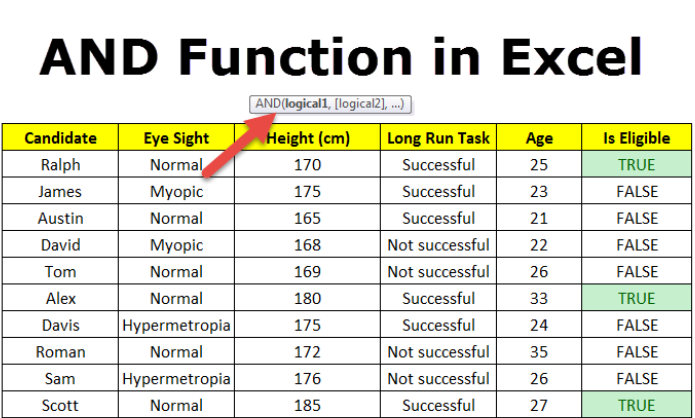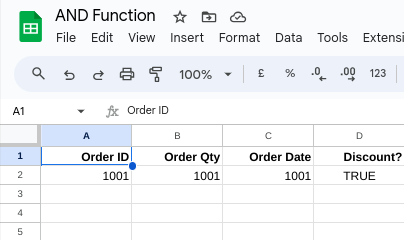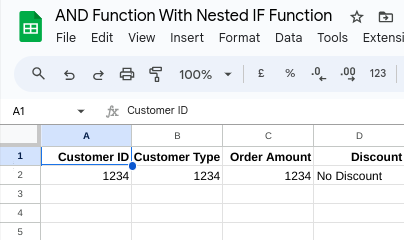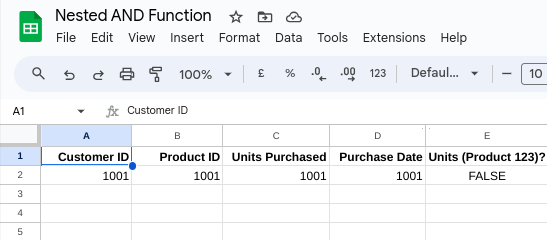Working professionals
Fresh graduates
- Study abroad
- Offline centres
More
27. Columns in Excel
33. Count In Excel
49. Slicers in Excel
54. Solver in Excel
56. Macros In Excel
AND Function in Excel
Every time I use MS Excel, I always rely on the AND function in Excel formula to uncomplicate things. This function has come to my rescue every time I need to test multiple conditions all at once.
If you have yet to figure out how and when to use it, you’ve come to the right place. I’ve carefully curated this tutorial covering everything you need to know about this function. After all, you can achieve valid outcomes only if every condition is met. From simple functions to complex ones, you will be able to navigate Excel more easily by the end.

Source: Wall Street Mojo
What is the AND Function?
The AND function in Excel formula is a logical function that lets you check if multiple conditions are all TRUE at the same time. But, you need to meet all the requirements (conditions) to get the said result (TRUE). It evaluates multiple conditions and returns TRUE only if all of them are TRUE. If even one condition is FALSE, the entire AND function returns FALSE.
Working with the AND function is incredibly easy.
The formula is
=AND(condition1, condition2, ...).
Just replace condition1, condition2, etc., with your actual conditions. These can be cell references (like A1>5), comparisons (like B1="Apple"), or even other formulas that return TRUE or FALSE.
You can use the AND function to check if an order is valid, like in this case:
=AND(A1>0, B1<>"Cancelled")
This formula checks if the order quantity (in cell A1) is greater than zero and if the order status (in cell B1) isn't cancelled. Only if both conditions are true will the formula return TRUE, indicating a valid order.
Learn more useful formulas like this with upGrad’s list of 25 advanced Excel formulas.
AND Function in Excel Syntax
This is the simple formulae that you have to apply:
=AND(condition1, condition2, ...)
Understand these further here:
- =: When the symbol = is placed in front, this signifies that an equation is starting and Excel program is being signaled.
- Condition1, condition2, …: Here are several things I want to check. You can use values like A1>10, B1=”Yes”, or any other formulas that give TRUE or FALSE.
- AND: This checks all the conditions listed in the sheet. If every single one evaluates to TRUE, then the whole formula returns TRUE. But if even one condition is FALSE, the entire formula flips to FALSE.
Characteristics of the AND Function
Here are some characteristics of the AND function in Excel formula:
- Syntax: It has an easy syntax. You don’t have to struggle with any cryptic codes when using this function, as it operates in plain English.
- Flexibility: Flexibility is another advantage of AND as it can be set to meet any number of requirements for different situations.
- Boolean output: With the AND function in Excel, you can expect to receive a TRUE or FALSE value based on conditions. This makes your job even easier, making it a cakewalk.
How to use the AND function in Excel formula
Here's how to use the AND function in Excel syntax:
=AND(condition1, condition2, ...)
Replace condition1, condition2, etc. with the actual conditions you want to check. These are explained here:
- Cell references (e.g., A1>10): Compares the value in a cell to a number or text.
- Comparisons (e.g., B1="Apple"): Checks if the value in a cell matches specific criteria.
- Other formulas that return TRUE or FALSE (e.g., =SUM(C1:C5)>20): Uses the results of other formulas in your AND function.
How the output of AND function looks like
The output of the AND function in Excel formula is always very simple: TRUE or FALSE.
And this is how it works:
- TRUE: This means that all the conditions you have specified in the AND function are fulfilled.
- FALSE: This means that at least one of the conditions you have specified in the AND function isn't fulfilled.
The AND function doesn't return any intermediate values or calculations. It acts like a strict gatekeeper - only if all conditions are met (TRUE) does it allow the formula to continue and return TRUE. Otherwise, it closes the gate and returns FALSE.
For example, if your AND function checks two conditions (A1>10 and B1="Apple"), the output will be
- TRUE: If the value in cell A1 is greater than 10 and the value in cell B1 is exactly "Apple" (case sensitive).
- FALSE: In any other scenario. This could be because the value in A1 is less than or equal to 10 or because the value in B1 differs from "Apple" (e.g. "Banana").
AND function in Excel formula with examples
It’s best to explain the AND function in Excel with examples. Here’s my take on this.
Example 1: AND function
Let’s say you have a spreadsheet for customer orders. You want to identify orders that qualify for a discount based on two criteria: minimum order quantity and early bird purchase.
Here's how you can use the AND function:

Source: MS Excel
Formula
=AND(A1>10, B1<DATE(YEAR(TODAY()),12,1))
where,
- A1>10: Checks if the order quantity in cell A1 is greater than 10.
- B1<DATE(YEAR(TODAY()),12,1)): Checks if the order date in cell B1 is earlier than December 1st of the current year. The DATE function creates a reference date for comparison.
Output:
Two outputs are possible in this scenario.
- If the order quantity is greater than 10 and the order date is before December 1st, the formula will return TRUE. This indicates the order qualifies for the discount.
- If either condition is not met (e.g., order quantity is 8 or order date is December 2nd), the formula will return FALSE, signifying the order doesn't qualify for the discount.
Example 2: AND function with nested IF function
Let’s say, you run a clothing store and offer discounts based on both the order amount and customer type (regular or premium). Here's how you will be using the AND function in Excel formula:

Formulas
=IF(AND(A1="Premium",B1>0),"Premium (15% Off)",IF(AND(A1="Regular",B1>100),"Regular (10% Off)","No Discount"))
where,
- "Premium" customer: If A1 is "Premium", the formula returns the text "Premium (15% Off)". This indicates that the customer receives a 15% discount (you can adjust the discount amount within the text).
- Nested IF for regular customers: If A1 is not "Premium", the first nested IF function checks for regular customers ("Regular") and the order amount (B1).
- Regular customer with orders over $100: If A1 is "Regular" and B1 is greater than 100, the formula returns "Regular (10% Off)". This signifies a 10% discount for regular customers with qualifying order amounts.
- Regular customer with the order below $100 or another customer type: If neither of the previous conditions is met, the nested IF function simply returns "No Discount".
- AND Function: The nested IF function for regular customers uses the AND function (AND(A1="Regular",B1>100)) to ensure both criteria (customer type and order amount) are met for the discount.
Example 3: Nested AND function
Imagine you're a data analyst reviewing customer purchases. Speaking of which, consider taking a course on introduction to data analysis in Excel if you’re planning to get into the field.
Let’s get back to the example. Using the AND function in Excel formula, you want to identify customers who meet all the following criteria –-purchased a specific product (Product ID = 123), purchased more than 5 units of that product, and purchase date was within the last quarter (current quarter minus 3 months.)

Formula
=AND(A1=123, B1>5, C1>=DATE(YEAR(TODAY()),MONTH(TODAY())-3,1))
where:
- A1=123: Checks if the product ID in cell A1 matches the target product (ID 123).
- B1>5: Checks if the number of units purchased in cell B1 is greater than 5.
- DATE(YEAR(TODAY()),MONTH(TODAY())-3,1): This part calculates the beginning date of the last quarter. It uses the YEAR and MONTH functions to get the current year and month, subtracts 3 from the month to go back 3 months, and sets the day to 1 to represent the beginning of the quarter.
- C1>= ...: This compares the purchase date in cell C1 to the calculated beginning date of the last quarter. It ensures the purchase happened within the last 3 months.
Output:
If all these conditions are TRUE, the formula will return TRUE in cell E2. Otherwise, it will return FALSE.
Limitations of AND function in Excel
The AND function in Excel formula is a workhorse for evaluating multiple conditions simultaneously. But like any tool, it has some considerations to keep in mind for optimal use:
- Data compatibility: The AND function primarily works with logical values (TRUE/FALSE) and comparisons that result in TRUE/FALSE. In older Excel versions (pre-2016), you might need additional formulas to convert text or numbers into a format the AND function can understand.
- Nesting complexity: While nesting allows combining many conditions, overly complex formulas can become difficult to read and maintain. For intricate logic, newer versions (Excel 2016+) offer functions like IFS, which can simplify tangled conditions.
- Version quirks: Minor differences exist across Excel versions. In the past, some versions limited the number of conditions an AND function could handle within a single formula. Thankfully, these limitations have generally been relaxed in newer versions.
- False starts: Remember, the AND function only returns TRUE if all conditions are met. A single FALSE among your conditions flips the entire formula to FALSE. Double-check your logic and data to ensure all criteria are on point.
Final Words
I use the AND function in an Excel formula to stipulate different conditions in one go. It makes the data analysis process precise and quick.
Speaking of which, if you are looking for a reliable data analysis course, upGrad should be your first pick. They provide multiple courses affiliated with prestigious universities all around the globe!
Frequently Asked Questions
1. How do I use the AND function in Excel?
To use the AND function in Excel formula, use this format: =AND(condition1, condition2, ...). Now, replace condition1, condition2, etc., with your actual conditions in the form of cell references, comparisons, or even logical expressions. To use the AND function in Excel formula, use this format: =AND(condition1, condition2, ...) . Now, replace condition1, condition2, etc., with your actual conditions in the form of cell references, comparisons, or even logical expressions. What is the & formula in Excel?
2. What is the & formula in Excel?
The AND function in Excel formula is not a single specific formula but a function that helps you take multiple conditions and evaluate them. The AND function in Excel formula is not a single specific formula but a function that helps you take multiple conditions and evaluate them. How do you use AND OR in Excel formula?
3. How do you use AND OR in Excel formula?
The usage of AND in Excel has been illustrated in detail in this tutorial. What is the AND symbol in Excel formula?
4. What is the AND symbol in Excel formula?
We employ the ampersand (&) symbol for AND function in Excel formula. We employ the ampersand (&) symbol for AND function in Excel formula. How do you put 2 conditions in IF Excel?
5. How do you put 2 conditions in IF Excel?
You can put 2 conditions in an IF statement using two different methods —AND and OR. For AND function, use =IF(AND(condition1, condition2), value_if_true, value_if_false). Similarly, for OR, use =IF(OR(condition1, condition2), value_if_true, value_if_false). You can put 2 conditions in an IF statement using two different methods — AND and OR . For AND function, use =IF(AND(condition1, condition2), value_if_true, value_if_false) . Similarly, for OR , use =IF(OR(condition1, condition2), value_if_true, value_if_false) . What are the 10 logical functions in Excel?
6. What are the 10 logical functions in Excel?
Excel's logical functions include AND, OR, NOT, IF, IFS (Excel 2016+), XOR (Exclusive OR), TRUE, FALSE, ISBLANK, and ISLOGICAL. The most commonly used ones are, however, AND, OR, IF, ISBLANK, and ISLOGICAL. Excel's logical functions include AND , OR , NOT , IF , IFS (Excel 2016+), XOR (Exclusive OR), TRUE , FALSE , ISBLANK , and ISLOGICAL . The most commonly used ones are, however, AND , OR , IF , ISBLANK , and ISLOGICAL . What is the AND function symbol in Excel?
7. What is the AND function symbol in Excel?
To write an AND function for checking different conditions, use this format: =AND(A1>5, B1<10). Over here, the AND function evaluates multiple conditions logically instead of concatenating. To write an AND function for checking different conditions, use this format: =AND(A1>5, B1<10) . Over here, the AND function evaluates multiple conditions logically instead of concatenating. How do you do IF with two conditions in Excel?
8. How do you do IF with two conditions in Excel?
To use the IF function with two conditions in Excel, you can combine the IF function with the AND or OR functions. To use the IF function with two conditions in Excel, you can combine the IF function with the AND or OR functions.

Author|15 articles published


upGrad Learner Support
Talk to our experts. We are available 7 days a week, 10 AM to 7 PM
Indian Nationals
Foreign Nationals
Disclaimer
The above statistics depend on various factors and individual results may vary. Past performance is no guarantee of future results.
The student assumes full responsibility for all expenses associated with visas, travel, & related costs. upGrad does not .






















-7f4b4f34e09d42bfa73b58f4a230cffa.webp&w=128&q=75)
-ae8d039bbd2a41318308f8d26b52ac8f.svg)



